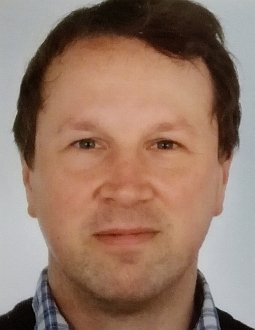Dr. Jens Turowski

Function and Responsibilities:
Senior research scientist.
Coordinator of the physical laboratories of Section 4.6 Geomorphology.
Ombudsperson for doctoral training.
Research Interests:
My scientific field is geomorphology, the study of landscapes, their evolution, and of the processes shaping them. My interest in general is in the interaction between climate, tectonics, and Earth surface processes. My research centers on furthering the understanding of the physical processes that shape the Earth’s surface by detailed observations, theoretical work, and analogue or numerical modelling. In my work, I collect field data with state-of-the-art instrumentation, and analyze and interpret it with statistical and theoretical methods.
In the past, my research has focused on fluvial geomorphology of mountain streams, with a particular focus on bedrock channels and step-pool systems. In addition, I am interested in the design and testing of new field instrumentation, in channel-hillslope coupling, and in the sediment cascade.
Some of my research themes are listed below. Each topic links to a recent and/or representative paper (so far as I have published on the topic).
Bedload transport
- Bedload transport as a physical process
- Initiation of bedload motion
- The stochasticity of bedload transport
- Bedload transport in steep mountain streams
- Measuring bedload transport with indirect sensors
Bedrock channel dynamics and fluvial bedrock erosion
- Fluvial bedrock erosion as a physical process
- Bedrock channel morphology and evolution
- The cover effect in fluvial bedrock erosion
- Field-testing of erosion models
- Measuring bedrock erosion at high spatial and temporal resolution
Mountain channel processes
- Step-pool channel morphology and evolution
- Channel roughness and flow velocity
- Channel-hillslope coupling and bank erosion
Organic matter in stream systems
Rockfall-dominated landscapes
The society and the geomorphology of mountain regions
- Extreme events
- Natural hazards in mountain landscapes
- The relevance of bedload transport processes to society
Field techniques in geomorphology
- Monitoring bedload transport in natural streams
- Field techniques for measuring bedrock erosion
- Measuring topography for geomorphic analysis
- Seismic techniques for the monitoring of Earth surface processes
Field areas
TaiwanTaiwan provides an excellent natural laboratory for the study of Earth surface processes, and there are several reasons for this. Firstly, erosion processes happen very quickly, and are consequently easy to study. The sediment discharge from Taiwan to the ocean between 1970 and 1999 added up to 384 Mt/yr, which accounts for 1.9% of the world-wide total. This compares to a fraction of only 0.024% of the Earth’s landmass. Secondly, Taiwan provides a suitable infrastructure for access. None of the parts of the islands are too remote to get to, there are hotels and other useful infrastructure. In addition, more than 200 discharge gauging stations are operated by the Water Resources Agency, with data reaching back more than 60 years. Thirdly, there is a wealth of scientific knowledge to build upon. And fourthly, Taiwan’s climatic setting in the tropical pacific typhoon belt gives very variable weather conditions, and extreme events occur at a high frequency. This allows sampling a wide range of event magnitudes in a relatively short time frame.
An important research site in Taiwan is Lushui station in Taroko National Park. Fluvial bedrock erosion and bedrock channel morphology have been investigated there in several studies.
European Alps
The European Alps are the closest major mountain belt, and many opportunities for scientific work arise there. I have been working in various catchments in the Swiss, Austrian, and French Alps, but most of my work was focused on four sites with exceptional data quality.
The Erlenbach is a small catchment in the Swiss pre-Alps near the town of Einsiedeln, hosting several scientific observatories focusing on hydrology, forest ecology, stream dynamics and sediment transport. The data set on bedload transport is probably the most detailed in the world, with high-quality measurements reaching back to 1982. The wealth of background information allows to study a wide range of phenomena on hydraulics, channel dynamics, bedload transport processes, and sediment routing. In addition, the Erlenbach is an important natural laboratory for testing new instruments for monitoring of bedload transport.
The Pitzbach, located near the village of Imst in Austria, hosted a unique system for measuring bedload yields continuously at high temporal resolution. The data set spans two years (1994-1995) at 15 minute intervals, and provides a rare opportunity for detailed statistical analysis of bedload discharge from a partly glaciated catchment.
The Illgraben near the town of Leuk in southern Switzerland is one of the most active debris flow channels in Europe, typically featuring 3-5 events per year. The catchment is equipped with abundant scientific instrumentation and has yielded unique insights into debris flow behavior.
The Gornera, near Zermatt and the Matterhorn, has carved a spectacular gorge into the bedrock. There, regular controlled floods allow detailed studies of the relationship between sediment transport and fluvial bedrock erosion.
Career:
Since 2019: Section head (ad interim) of Section 4.6 Geomorphology at the GFZ German Centre for Geosciences, Germany
Since 2013: Senior researcher at the GFZ German Centre for Geosciences, Germany
2010-2013: Research Scientist at the Swiss Federal Institute for Forest, Snow and Landscape Research WSL, Switzerland
2007-2010: Post-doctoral researcher at the Swiss Federal Institute for Forest, Snow and Landscape Research WSL, Switzerland
Education:
2007: Thesis: Controls on bedrock channel morphology - Experimental and theoretical investigations and comparison with natural channels2003-2007: Doctoral thesis at the Department of Earth Sciences, University of Cambridge, UK
1999-2003: Degree studies in Experimental and Theoretical Physics, Peterhouse, University of Cambridge, UK
Projects:
We recently published the sedFlow Modell for bedload transport simulations in mountain streams. sedFlow is a flexible model environment and can be used both for scientific and operational purposes.
Publications:
Heimann et al., 2015, sedFlow - a tool for simulating fractional bedload transport and longitudinal profile evolution in mountain streams, Earth Surface Dynamics 3, 15-34, doi: 10.5194/esurf-3-15-2015
Heimann et al., 2015, Calculation of bedload transport in Swiss mountain streams using the model sedFlow - proof of concept, Earth Surface Dynamics 3, 35-54, doi: 10.5194/esurf-3-35-2015
Junker et al., 2015, Assessing the impact of climate change on brown trout (Salmo trutta fario) recruitment, Hydrobiologia 751, 1-21, doi: 10.1007/s10750-015-2223-3
Rickenmann et al., 2014, Simulation of bedload transport in the Hasliaare River with increased sediment input, River Flow 2014, Schleiss et al. (Eds.), Taylor & Francis Group, London, 2273-2281, ISBN 978-1-138-02674-2, doi: 10.1201/b17133-303
Lithological properties of rocks, erodibility and landscape evolution
Erosion rates are modulated by the properties of the rock that is eroded, which is quantified in a parameter known as erodibility. However, it is unclear how exactly erodibility is related to rock properties for many erosion processes, including coastal erosion, fluvial erosion, and glacial erosion. In the project, we try to discriminate lithological controls on erosion rates and develop concepts to unite the concept of erodibility for various types of landscapes and erosion processes.
Project members: Claire Masteller, Sam Wilson-Fletcher, Jens Turowski, Niels Hovius
Rockfall processes and rockfall-dominated landscapes
Rockfalls are a major natural hazard in mountain landscapes, and they have been widely studied from a hazard perspective. However, there are many open questions, for example relating to rockfall triggers, block production or to the long-term evolution of steep rock walls. We investigate rockfall processes with seismic methods, allowing a precise location in time and a comparison to prossible trigger conditions. As part of the project, we constructed the Reintal Rockfall Observatory in the German Alps.
Project members: Michael Dietze, Anne Schöpa, Jens Turowski, Niels Hovius
Collaborations: Michael Krautbaltter (TUM, Germany)
Systematic seismic characterisation of geomorphic processes
We exploit opportunities offered by prototype-scale experiments and natural laboratories world-wide, accessed through collaborations with local researchers. High quality seismic data are collected in parallel with independent observations of surface processes to constrain the relations between these processes and their seismic records and to create a library of seismic data of well-constrained geomorphological events for benchmarking of future seismological work.
Project members: Michael Dietze, Anne Schöpa, Jens Turowski, Niels Hovius
Collaboration: Jonathan Laronne (University of the Negev, Israel), Danica Roth (University of Oregon, USA), Dan Cadol (New Mexico Institute of Mining and Technology, USA), Lina Polvi Sjöberg (Umea University, Sweden)
Bedrock channel morphology and sediment-flux-driven bedrock erosion
We try to understand fluvial bedrock erosion processes and how the influence and set bedrock channel morphology. This is done with theoretical experiments, experiments and field investigation. Field measurements are obtained from a number of streams in Taiwan and Switzerland.
Project members: Jens Turowski
Collaborations: Alexander Beer (CalTech, USA), James Kirchner (Swiss Federal Institute of Technology, Switzerland), Rebecca Hodge (University of Durham, UK), Liran Goren (University of the Negev, Israel)
Research Boards and Committees:
Scientific societies, conferences and workshops2015-2019: Deputy, Geomorphology Division, European Geosciences Union (EGU)
Since 2005: Session Organiser and chair, EGU General Assembly
2011-2014: Coordinator for workshops for young scientists in the Geomorphology Division at the General Assembly of the European Geosciences Union (EGU)
2013: Organising committee: International workshop of acoustic and seismic monitoring of bedload and mass movements, September 2013, Birmensdorf, Switzerland
2009-2013: Programme Committee, Geomorphology Division, European Geosciences Union (EGU)
2009-2013: Deputy, Geomorphology Division, European Geosciences Union (EGU)
Editorial work
Since 2013: Associate Editor for the journal Earth Surface Dynamics (EGU, Copernicus)
2015: Special Issue: Acoustic and seismic monitoring of bedload and mass movements, Earth Surface Dynamics
2015: Special issue: Morphodynamics of steep mountain channels, Earth Surface Processes and Landforms
2013: Special issue: Process geomorphology and ecosystems: disturbance regimes and interactions, Geomorphology
2012: Special issue: Disturbance regimes at the interface of geomorphology and ecology, Earth Surface Processes and Landforms
Awards:
2019: Kirk Bryan Award for Cook, Turowski, Hovius "River gorge eradication by downstream sweep erosion", Nature Geoscience 2014.
2017: 2016 Editor's citation for excellence in refereeing, Geophysical Research Letters, American Geophysical Union2016: Invited State-of-Science article on Field techniques for measuring bedrock erosion in the journal Earth Surface Processes and Landforms
2015: 2014 Editor's citation for excellence in refereeing, Water Resources Research, American Geophysical Union
2011: 2010 Editor's citation for excellence in refereeing, Journal of Geophysical Research (Earth Surface), American Geophysical Union
2010: Keynote / invited review article on semi-alluvial channels for Gravel Bed Rivers 7 (September 2010, Tadoussac, Quebec, Canada)
2003-2007: Peter Scheuer Research Student, Peterhouse, Cambridge, UK
2003-2006: NERC Blue Skies Research Studentship, UK


